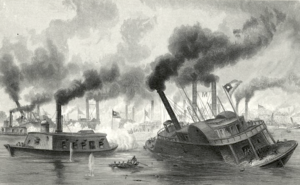| First Battle of Memphis | |||||||
|---|---|---|---|---|---|---|---|
| Part of American Civil War | |||||||
 Battle of the Rams by A. R. Waud | |||||||
| |||||||
| Belligerents | |||||||
|
|
| ||||||
| Commanders and leaders | |||||||
|
|
| ||||||
| Units involved | |||||||
|
Benton Louisville Carondelet Cairo St. Louis Ram Queen of the West Ram Monarch Ram Lancaster Ram Switzerland |
CSS General Beauregard CSS General Bragg CSS General Sterling Price CSS General Earl Van Dorn CSS General M. Jeff Thompson CSS Colonel Lovell CSS General Sumter CSS Little Rebel | ||||||
| Strength | |||||||
|
5 ironclads 4 rams | 8 rams | ||||||
| Casualties and losses | |||||||
|
1 ram disabled 1 mortally wounded |
7 rams destroyed or captured approx. 100 killed or wounded approx. 150 captured | ||||||

The First Battle of Memphis was a naval battle fought on the Mississippi River immediately north of the city of Memphis, Tennessee on June 6, 1862, during the American Civil War. The engagement was witnessed by many of the citizens of Memphis. It resulted in a crushing defeat for the Confederate forces, and marked the virtual eradication of a Confederate naval presence on the river. Despite the lopsided outcome, the Union Army failed to grasp its strategic significance. Its primary historical importance is that it was the last time civilians with no prior military experience were permitted to command ships in combat. As such, it is a milestone in the development of professionalism in the United States Navy.[1]
- ^ Abbreviations used in this article: ORA – War of the Rebellion; a compilation of the official records of the Union and Confederate Armies, 70 volumes in four series; Washington: US Government Printing Office, 1880–1901. ORN – Official records of the Union and Confederate Navies in the War of the Rebellion, 30 volumes in two series; Washington: US Government Printing Office, 1894–1922.